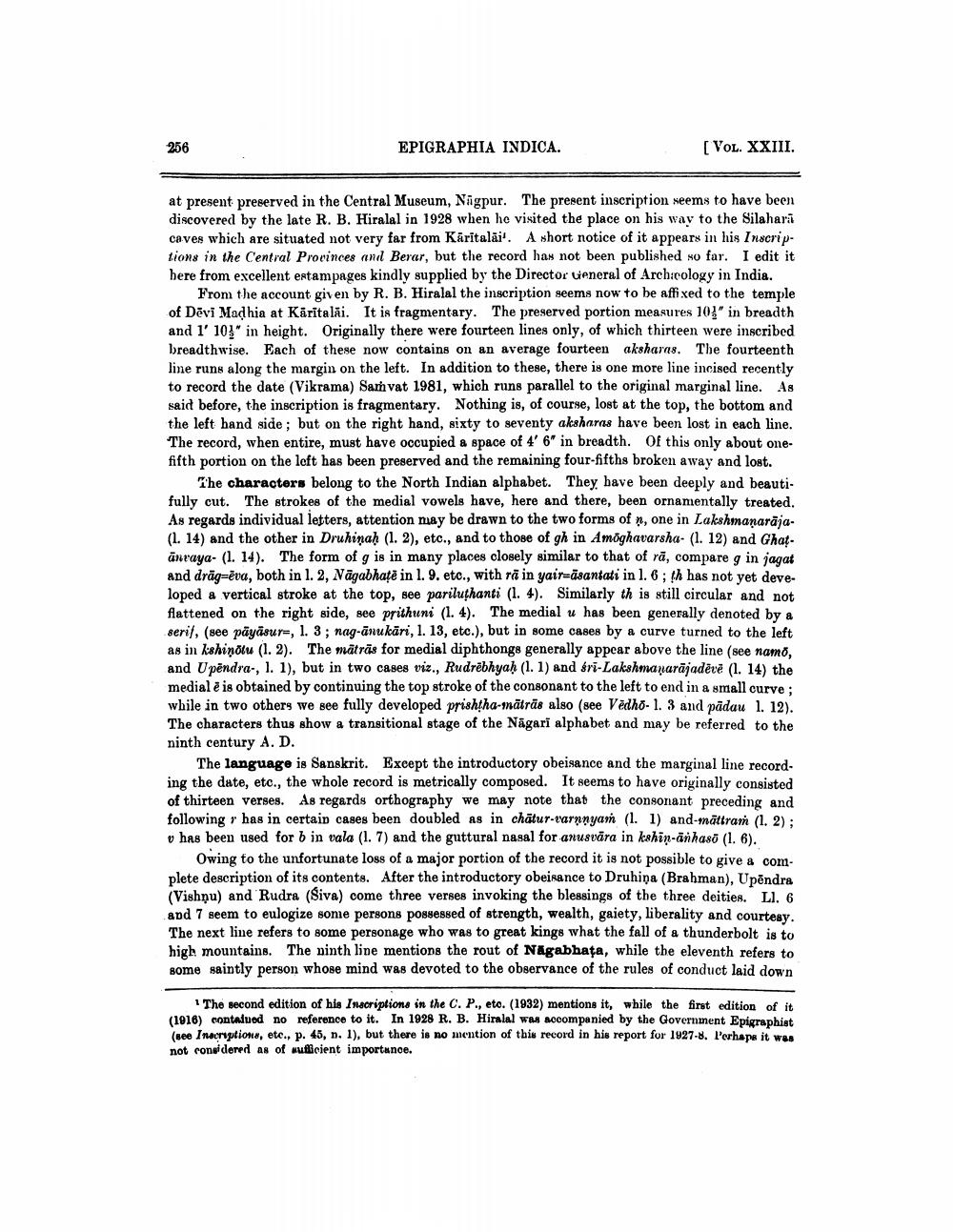________________
256
EPIGRAPHIA INDICA.
[VOL. XXIII.
at present preserved in the Central Museum, Nagpur. The present inscription seems to have been discovered by the late R. B. Hiralal in 1928 when he visited the place on his way to the Silahara caves which are situated not very far from Kārītalai'. A short notice of it appears in his Inscriptions in the Central Provinces and Berar, but the record has not been published so far. I edit it here from excellent estampages kindly supplied by the Director General of Archaeology in India.
From the account given by R. B. Hiralal the inscription seems now to be affixed to the temple of Devi Madhia at Kārītalai. It is fragmentary. The preserved portion measures 101" in breadth and 1' 101" in height. Originally there were fourteen lines only, of which thirteen were inscribed breadthwise. Each of these now contains on an average fourteen aksharas. The fourteenth line runs along the margin on the left. In addition to these, there is one more line incised recently to record the date (Vikrama) Samvat 1981, which runs parallel to the original marginal line. As said before, the inscription is fragmentary. Nothing is, of course, lost at the top, the bottom and the left hand side; but on the right hand, sixty to seventy aksharas have been lost in each line. The record, when entire, must have occupied a space of 4' 6" in breadth. Of this only about onefifth portion on the left has been preserved and the remaining four-fifths broken away and lost.
The characters belong to the North Indian alphabet. They have been deeply and beautifully cut. The strokes of the medial vowels have, here and there, been ornamentally treated. As regards individual letters, attention may be drawn to the two forms of n, one in Lakshmaṇarāja(1. 14) and the other in Druhinaḥ (1. 2), etc., and to those of gh in Amoghavarsha- (1. 12) and Ghatanraya- (1. 14). The form of g is in many places closely similar to that of ra, compare g in jagat and drag-ēva, both in 1. 2, Nagabhate in 1. 9. etc., with ra in yair-äsantati in 1. 6; th has not yet developed a vertical stroke at the top, see pariluthanti (1. 4). Similarly th is still circular and not flattened on the right side, see prithuni (1. 4). The medial u has been generally denoted by a serif, (see pāyāsur-, 1. 3; nag-ānukāri, 1. 13, etc.), but in some cases by a curve turned to the left as in kshinötu (1. 2). The matras for medial diphthongs generally appear above the line (see namo, and Upendra-, 1. 1), but in two cases viz., Rudrēbhyaḥ (1. 1) and śri-Lakshmaṇarājadēvē (1. 14) the medial è is obtained by continuing the top stroke of the consonant to the left to end in a small curve; while in two others we see fully developed prishtha-mātrās also (see Vedhō- 1. 3 and padau 1. 12). The characters thus show a transitional stage of the Nagari alphabet and may be referred to the ninth century A. D.
The language is Sanskrit. Except the introductory obeisance and the marginal line recording the date, etc., the whole record is metrically composed. It seems to have originally consisted of thirteen verses. As regards orthography we may note that the consonant preceding and following has in certain cases been doubled as in chatur-varnnyaṁ (1. 1) and-mättraṁ (1. 2); v has been used for b in vala (1. 7) and the guttural nasal for anusvāra in kshin-ānhasō (1. 6).
Owing to the unfortunate loss of a major portion of the record it is not possible to give a complete description of its contents. After the introductory obeisance to Druhina (Brahman), Upendra (Vishnu) and Rudra (Siva) come three verses invoking the blessings of the three deities. Ll. 6 and 7 seem to eulogize some persons possessed of strength, wealth, gaiety, liberality and courtesy. The next line refers to some personage who was to great kings what the fall of a thunderbolt is to high mountains. The ninth line mentions the rout of Nagabhata, while the eleventh refers to some saintly person whose mind was devoted to the observance of the rules of conduct laid down
1 The second edition of his Inscriptions in the C. P., etc. (1932) mentions it, while the first edition of it (1916) contained no reference to it. In 1928 R. B. Hiralal was accompanied by the Government Epigraphist (see Inscriptions, etc., p. 45, n. 1), but there is no mention of this record in his report for 1927-8. Perhaps it was not considered as of sufficient importance.




